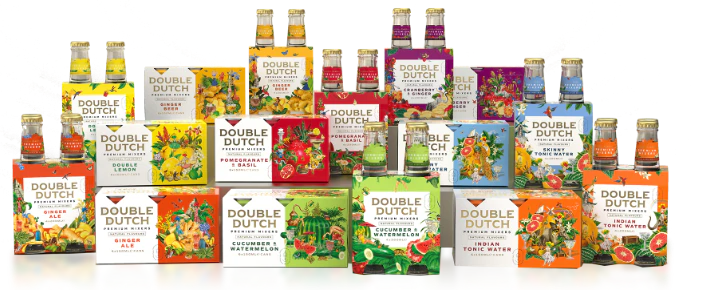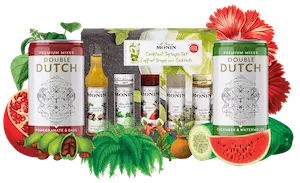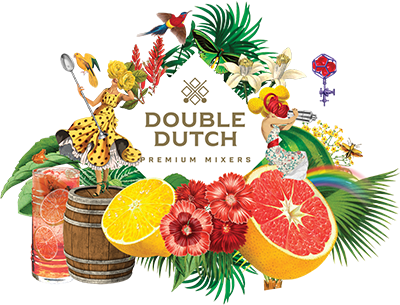All things Gin! A history of the nation's most loved spirit
All our lives we’ve proudly stated that the Netherlands is the birthplace of gin, and of course we’re right, except that original 13th century gin was nothing like the sophisticated spirit we love to drink today, so sit back, relax and enjoy the astonishing true story of how gin gained its popularity.
The Birth Gin (Sort of)
Back then, a drink known as genever was distilled from malt wine and it clearly tasted pretty bad as the distillers added herbs and spices to make it more potable. Juniper berries were popular because they were used for medicinal purposes (today we still use them in diabetic and diuretic treatments) as well as offering the fresh flavour which makes gin so distinctive. A form of gin was born.
The Birth of Real Gin
Three hundred years later the Dutch produced the first real gin - but it still remained a domestic product until about 1700 when London fell in love with gin. There are all kinds of complicated reasons for this - grain taxes, new trade relationships with Holland and mass urbanisation as poor people flooded into London seeking their fortunes - and now, London Dry Gin.
“Forget the cheap white wine: Go to beef and gin!” ~ Julia Child
Why gin?
When people lived in villages, they either brewed their own beer or went to an alehouse to drink ale. More accurately - women brewed beer at home and men drank it in alehouses after finishing their day’s work in the fields.
Moving to the City
Suddenly, in the big city, everybody could drink gin and they could drink it whenever they wanted, because they weren’t tied to growing and harvesting crops all the daylight hours. Gin was like a massive, constant, dirt-cheap TGIF and it came, like beer, in pints.
Yes, in the 1700s Londoners drank their gin in pints, often hot, and served with gingerbread!
London’s Love for Gin
The poor - which was most of London’s population - loved gin so much they called it Madam Geneva, and attempts to ban binge drinking led to riots in 1736, known as the Glorious Revolution.
By 1743 gin production was at an all time high, with 10 million gallons of the distilled spirit produced annually in London alone. Madam Geneva, renamed Mother’s Ruin, was being blamed for infanticide, mental illness and prostitution, known as the gin craze. Not the kind of thing you see on a gin distiller’s billboards today, that’s for sure!
Of all the gin joints in all the towns in all the world, she walks into mine” ~ Humphrey Bogart in Casablanca
The Gin Act of 1751
Further attempts to tax gin were counterproductive; nobody bought a licence to produce or sell gin and when the government offered rewards for turning in unlicensed gin merchants, mobs began to beat up anybody who was even suspected of telling tales. At the same time, organised crime set up protection schemes, taking money from gin sellers in order not to be outed to the government. It was pretty messy. So obviously, what everybody needed in this situation was a gin-dispensing cat, right?
“The proper union of gin and vermouth is a great and sudden glory; it is one of the happiest marriages on earth, and one of the shortest lived.” ~ Bernard DeVoto
The Puss and Mew
The world’s earliest vending machine was known as the Puss and Mew, and it was designed to get around the issue of being fined for selling gin without a licence.
A gin merchant would board up a window that was far from the building’s front door, and mount a low relief sculpture of a larger-than-life cat on it. The gin drinker would walk up to the cat and proclaim, “Puss, give me two pennyworth of gin” and put his or her pennies in the cat’s mouth. They would slide down a tube to the seller who would then pour the measure of gin down a lead pipe that emerged from that cat’s upraised paw.
The window being far from the door prevented the seller being associated with the buyer and as nobody could actually see both sides of the transaction, no charge could be levelled.
19th Century
By 1830, gin was changing. A new form of distilling meant that purer spirits could be produced and gin producers saw this as their chance to rehabilitate the capital’s most troubled tipple.
Gin’s Adoption by English Soldiers
At the same time, The Royal Navy started to impose quinine on sailors to prevent malaria and also began to carry gin on long voyages as it travelled better than beer. Quinine tasted terrible, so Indian Tonic Water was invented to get sailors to actually drink their medicine, and naturally they began to combine it with gin, inventing the G&T.
The First Gin cocktail
Soon another component of the earliest gin cocktails was added to the mix; limes. Limes were carried on ships to combat scurvy and actually caused British sailors to be nicknamed Limeys. And gin and lime is what came to be known as a gimlet.
A new love affair with gin had began. In 1869, the UK’s first cocktail recipe book was published, William Terrington's Cooling Cups and Dainty Drinks, and the very first recipe was gin, ginger syrup, orange curaçao and bitters.
“He was white and shaken, like a dry martini.” ~ P. G. Wodehouse
Gin Today
Today, gin is officially Britain’s favourite spirit, with more than half the 18-24 age group saying they drink gin. Craft gin brands offer a range of flavours and credentials such as super local, organic, uniquely flavoured, limited edition and even mineralised with gold or silver flakes.
Dutch Courage with Double Dutch
Of course, the proliferation of new mixers to pair with these new gins is where Double Dutch takes centre-stage. More than a third of gin served in the UK is now drunk with something other than the classic tonic, and our mission of ‘never drink dull’ has risen to the challenge.
Gin Combination Ideas
Try our Double DutchCucumber & Watermelonwith your favourite gin for a simple spritzer, or pink gin combined with Double DutchPomegranate & Basil and fresh or chocolate-coated strawberries for a romantic cocktail - recipes on our Double Dutch site, of course!









